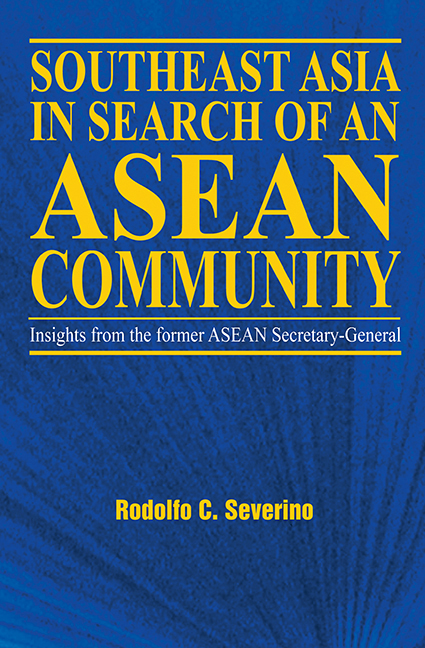Book contents
- Frontmatter
- Contents
- Foreword
- Introduction
- About the Author
- Acknowledgements
- Glossary
- 1 The “ASEAN Way”: Its Nature and Origins
- 2 Who Belongs in ASEAN? The Question of Membership
- 3 The Issue of Non-Interference
- 4 Regional Security: The ASEAN Role
- 5 Integrating the Regional Economy
- 6 ASEAN and the World
- 7 The ASEAN Community: Is It for Real?
- 8 What Kind of Future for ASEAN?
- Appendices
- Interviews
- Index
7 - The ASEAN Community: Is It for Real?
Published online by Cambridge University Press: 21 October 2015
- Frontmatter
- Contents
- Foreword
- Introduction
- About the Author
- Acknowledgements
- Glossary
- 1 The “ASEAN Way”: Its Nature and Origins
- 2 Who Belongs in ASEAN? The Question of Membership
- 3 The Issue of Non-Interference
- 4 Regional Security: The ASEAN Role
- 5 Integrating the Regional Economy
- 6 ASEAN and the World
- 7 The ASEAN Community: Is It for Real?
- 8 What Kind of Future for ASEAN?
- Appendices
- Interviews
- Index
Summary
The Declaration of ASEAN Concord II, or Bali Concord II (BCII), which ASEAN's leaders issued at their summit in Bali on 7 October 2003, states in its first operative paragraph:
An ASEAN Community shall be established comprising three pillars, namely political and security co-operation, economic co-operation, and socio-cultural co-operation that are closely intertwined and mutually reinforcing for the purpose of ensuring durable peace, stability and shared prosperity in the region.
Although BCII is meant to present an integral and coherent vision of an ASEAN “community”, with its three components interacting with one another as parts of the whole, “closely intertwined and mutually reinforcing”, the document actually treats the three “pillars” highly discretely. This is perhaps inevitable in the light of the fact that different sets of officials drafted the three segments. This compartmentalized division of bureaucratic turf in turn reflects the lack of a body in any of the ASEAN countries that takes charge of ASEAN matters in a comprehensive manner. That lack is one of ASEAN's main institutional weaknesses.
AN ECONOMIC COMMUNITY
The concept of an ASEAN Community as envisioned at the ASEAN Summit in Bali in 2003 had its genesis in the proposal for an ASEAN Economic Community. At the ASEAN Summit in Phnom Penh on 4 November 2002, Prime Minister Goh Chok Tong of Singapore had proposed that the next stage in regional economic integration be named the ASEAN Economic Community. He and a few other ASEAN leaders were deeply concerned over the weakened ability of the ASEAN countries to attract foreign direct investment, on which all of them depended for sustained economic growth. This development was a consequence of the changes wrought by the Asian financial crisis in investors’ perceptions of Southeast Asia's economic prospects. Some of the proverbial “observers” attributed it also to the surge of China and, later, of India as competing destinations for investment.
- Type
- Chapter
- Information
- Southeast Asia in Search of an ASEAN Community , pp. 342 - 371Publisher: ISEAS–Yusof Ishak InstitutePrint publication year: 2006

